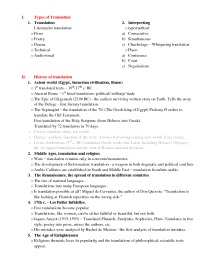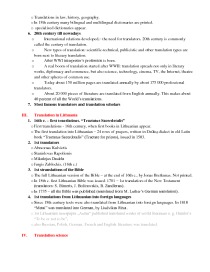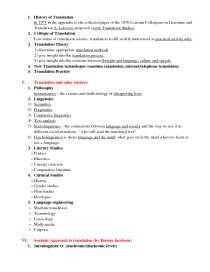Types Of Translation History Of Translation Translation Science



Types of Translation Translation. History of translation Acient world Egypt , Sumerian civilisation , Rome. Middle Ages , translation and religion. The Rennaissance , the spread of translation in different countries. Th. – Les Belles Infidelles. The Age of Enlightement. Th century till nowadays. Most famous translators and translation scholars Translation in Lithuania 16th. – first translations. “ Tractatus Sacerdotalis ”. St stranslations of the Bible. St translations from Lithuanian into foreign languages. Translation science History of Translation. Critique of Translation. New Translation technologies machine translation , internet telephone translation Translation Practice. Translation and other sciences Philosophy. Semiotic Approach to translation by Roman Jacobson Intralinguistic tr. Sinchronic diachronic levels. Theory of Dynamic Equivalence by Eugene Nida Two types of equivalence formal. Nida’s classical translation process model. Analysis surface structures are analysed and split into deep structure. Two different attitudes towards the translation theory Translation theory based on literature concepts. Translation theory as a part of linguistics. Functionalistic approach to translation Katharina Reiss and Hans Joseph Vermeer. The main idea of functionalistic approach in translation. Types of texts are distinguished by functionalists. Skopos Theory What does the word skopos mean. What is Skopos theory about. Communicative Interpretational translation theory Otto Kade and Peter Newmark. Communicative translation theory.
The Epic of Gilgamesh (2100 BC) - the earliest surviving written story on Earth. Tells the story of the Deluge - first literary translation.
The Septuagint – the translation of the 70: (The Greek king of Egypt) Ptolemy II orders to translate the Old Testament.
First translation of the Holy Scripture (from Hebrew into Greek).
Horace: aesthetic function of the texts. Advises borrowing/coining new words if necessary.
Livius Andronicus (3rd c. BC) translated Greek works into Latin, including Homer's Odyssey– the 1st signed translation and the start of Roman national literature.
The development of Reformation: translation - a weapon in both dogmatic and political conflicts
Arabic Califates are established in South and Middle East – translation from/into arabic
Jaques Amyot (1515-1593) – Translated Plutarch, Euripides, Sophocles, Plato. Translates in free style: poetry into prose, mixes the authors, etc.
His mistakes were analysed by Bachet de Mezirac –the first analysis of translation mistakes.
Religious thematic loses its popularity and the translations of philosophical, scientific texts appear.
International relations developed,– the need for translators. 20th century is commonly called the century of translation.
New types of translation: scientific-technical, publicistic and other translation types are born next to literary translation.
A real boom of translation started after WWII: translation spreads not only in literary works, diplomacy and commerce, but also science, technology, cinema, TV, the Internet, theatre and other spheres of common use.
About 20 000 pieces of literature are translated from English annually. This makes about 40 percent of all the World’s translations.
The first translation into Lithuanian – 24 rows of prayers, written in Dzūkų dialect in old Latin book “Tractatus Sacerdotalis” (Tractate for priests), issued in 1503.
The full Lithuanian version of the Bible – at the end of 16th c., by Jonas Bretkunas. Not printed.
In 18th c. first Lithuanian Bible was issued. 1701 – 1st translation of the New Testament (translators: S. Bitneris, J. Božinovskis, B. Zandlenas).
Since 18th century texts were also translated from Lithuanian into foreign languages. In 1818 “Metai” was translated into German, by Liudvikas Rėza.
Critique of TranslationLow status of translation science: translation is still widely understood as pracitcal activity only.
Diachronic level: translating old language into modern language (tr. Of G. Chaucer’s Canterbury Tales into modern English)
Synchronic level: paraphrasing. (informal l.. into formal/ translating from one dialect into another, explaining etc.).
and dynamicDynamic equivalence is when the reader of the TT feels the same effect of the text as the reader of the ST
3)restructuring: the transferred information is expressed with surface structures of language B, i. e. the text is created.

















